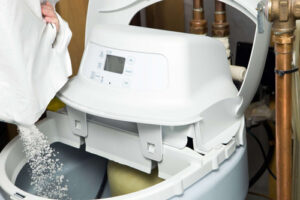Volatile Organic Chemicals form a vital element of many commercial and residential products. But once in the water supply, they can become very problematic.
How Volatile Organic Chemicals Get in Your Water
Volatile Organic Chemicals (VOCs) are chemical compounds that contain carbon and evaporate easily when exposed to air. These compounds come in a wide variety, some naturally occurring and some man-made. They can also serve many different purposes in commercial and residential products. Common examples include gasoline, rubber and plastic products, cosmetics, pharmaceuticals, and pesticides.
While not all VOCs are harmful, many are hazardous to humans and animals. Some are particularly dangerous because they readily dissolve in water. When these VOCs find their way into groundwater or public water systems, they can be transported far from their point of origin. They then evaporate into the air wherever water exits the system, like it does when you turn on a faucet.
VOCs typically enter the environment as a result of human activity. They most often reach water supplies through industrial activity, such as manufacturing and dry cleaning, or spills of commercial or residential products that are not cleaned up properly. Landfills and agricultural sites are also common sources of VOCs.
The Dangers of VOCs in Drinking Water
When it comes to your water, VOCs present a threat not only because of their negative health effects, but also because of how far they can travel once they dissolve in water. This means you can live quite a distance away from the site where a VOC was used or spilled and still suffer the consequences.
The EPA lists 53 harmful VOCs that public water suppliers must keep below established Maximum Contaminant Levels. However, this is a small fraction of the VOCs currently in use. There are so many VOCs, in fact, that it is impractical, if not impossible, for suppliers to consistently monitor for all of them. In addition, the long-term risks of many VOCs are unknown.
How to Prevent VOCs in Drinking Water
If you’re concerned about VOCs in your municipal drinking water, you should first check out your local Consumer Confidence Report (a list of reports for Maryland can be found here). In the report, you’ll find the results of recent water quality testing for your water system, as well as any steps that are being taken to control harmful substances.
Also, help keep your groundwater safe by following all local laws and packaging instructions when working with household chemicals, particularly if you spill any amount or when discarding the container. You should also report any issues with water quality, such as cloudiness or strange odor, to your local supplier. Outside of the EPA-mandated list discussed above, the presence of VOCs are often not tested for unless there is reason to suspect contamination, meaning water authorities rely in part on consumer feedback to identify potential issues.
The only way to truly know what is in your water is to have it tested. While there are at-home testing kits available, working with a water quality expert will help you determine the right solution for your treatment needs. One product does not fit all when it comes to water quality solutions, and working with trained professionals is ultimately more effective and less expensive in the long run than relying on trial and error.
To ensure your household always enjoys safe, high-quality water, you may consider installing a house-wide Reverse Osmosis Filter like Hague’s H6500 model. These filtration systems remove not only VOCs but also other dangerous chemicals, viruses, and dissolved solids. You’ll never be concerned about what’s coming out of your tap.



